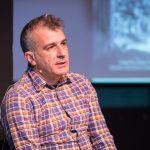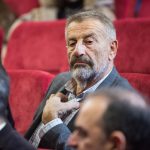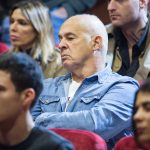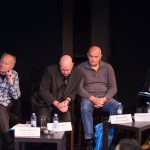
31 YEARS SINCE THE AGGRESSION OF THE JNA ON THE AREA OF DUBROVNIK AND THE SHELLING OF THE OLD TOWN
07/12/2022
International Human Rights Day in Montenegro
09/12/2022Message from the conference “Dialogue to Face the Past”: All for Peace, All Against War

“The destructive and unreasonable war against Croatia and Dubrovnik had caused great and unprecedented trauma to Montenegrin and Croatian citizens, and a way to overcome that trauma is to talk about it”, said the Executive Director of the Human Rights Action (HRA) Tea Gorjanc Prelević at the panel entitled “Dialogue to Face the Past”, which was held yesterday in the Budo Tomović Hall of the ‘Dodest’ Culture and Information Centre in Podgorica.
Thirty one years that passed since the attack on Dubrovnik were marked with the testimonies of former reservists of the Yugoslav National Army (YNA) and participants in the defence of Dubrovnik, at the event organised by HRA and the Drama Studio Prazan Prostor [Empty Space].
“The goal is to help establish trust and reconciliation between the citizens of Montenegro and Croatia through a dialogue based on facts”, said Gorjanc Prelević.
She recalled that the Hague Tribunal dealt only with the most serious attack on the Old Town of Dubrovnik, which took place on 6 December 1991, while no one has been held accountable for other crimes, those that were committed in the wider Dubrovnik area during the seven-month siege.
Theatre director and professor at the Faculty of Dramatic Arts in Cetinje Petar Pejaković pointed out that young people who worked on the play “Death in Dubrovnik” knew nothing about the event, that no stories about the siege of Dubrovnik can be found in the textbooks, and that teachers do not mention it. “It is wrong to keep silent about it; children should know what happened, we should cultivate a culture of memory so that nothing like this happens ever again”, said Pejaković.
He explained that “Death in Dubrovnik” is a semi-documentary play based on the testimonies of people who were there during the events. He said that some 30 interviews were conducted with war participants from Montenegro, and that it is good that there are more and more of them who are willing to talk about it. He also said that it was difficult to listen to their confessions, and that he was shocked when he heard that in Morinje, among other things, “they made the prisoners bark at a light bulb”.
Assistant on the RECOM Reconciliation Network project, Danijela Vojinović, said that there is still no political will of the states when it comes to international reconciliation, and that the goal of her organisation is to establish the truth, support local initiatives aimed at dealing with the past, and present all the war crime experiences from the point of view of the victims. “It is important that there are plays and films, because they can spark the interest of the younger generation in this topic, so that things are not forgotten and repeated”, said Vojinović.
Journalist and former Yugoslav National Army reservist Veseljko Koprivica explained that Pobjeda and Radio Television of Montenegro were the pioneers of warmongering journalism. “Momir Bulatović called for war, Milo Djukanović used to say that he hated the ‘chessboard flag’ and that we will finally have a clear borders with Croatia, while Marović once called i a war for peace”, recalled Koprivica. He said that he was forced to go to Konavle, that he was one company’s driver, and that there was terrible looting and burning of houses: “But that was done by 10, maybe 15 reservists; the others tried to stop them, but they were threatened with words that will not see the dawn [if they did not stand down]”.
Journalist and publicist from Dubrovnik Luko Brailo recalled the photographs taken by young photographer Pavo Urban, who was documenting the destruction of Dubrovnik just before being killed on 6 December 1991.
“It is a fact that war is the worst possible form of communication between people; it is unimaginable what people are ready to do in a war, but it is also important to point out that not everyone is the same”, he added.
The testimony of president of the Assembly of Volunteers of the Dubrovnik-Neretva County and the War Invalids Club from Dubrovnik, Goran Žuvela, also told us that not everyone is the same. He said that on 6 December, while the city was burning, someone tricked the commander and disabled 38 grenades so that they would not explode. “A monument should be erected to that man for deactivating those grenades. Had they been active, Dubrovnik would have burned to the ground”, said Žuvela. He also emphasised that the women of Dubrovnik should also get a monument because they are the greatest, yet never mentioned victims: “If it were not for those women, Dubrovnik would have fallen”. He said that his sister was only three years old when her hair went gray from the shelling of the city.
Participant in the defence of Dubrovnik and a prisoner who was kept in Morinj camp, Zlatko Bagoje, said that he spent 66 days in Morinj, which he remembers as a ‘place of torture’: “Completely innocent people were brought in, old people were mistreated, humiliated, beaten”… He said that they were exposed to psychological terror and frightened by fake executions, that they had no food, that after a few days they were given wet blankets to cover themselves with… However, he also pointed out that there was a guard, Mladen Proročić – who was present in Dodesta Hall while Bagoje was speaking – who helped him find out where his family was, who also helped the other prisoners, who brought them cigarettes: “When he was on guard duty, we were practically free people”.
Former YNA reservist Marjan Šantić said he was threatened with threats to kill his family if he did not go to Dubrovnik. “The hardest thing for me was when I saw children’s toys hidden behind the fridge in one of the houses… Some people were buried in graves that were so shallow that their hands would come out of the soil when it started to rain”, remembered Šantić. He also said that he was afraid of what could happen to him in the future because of the things he said at the panel.
Journalist Brailo added that, for him, the hardest moment was in November 1991, when he put his wife and children on a ship, unsure whether he would ever see them again. “You learn how to wash your ears, face and body with a litre of water and still have some left to drink, you learn to be happy when you get a piece of bread”, he reminisced. He also said that shells kept falling on Dubrovnik all the way until the Dayton agreement at the end of 1995.
Attorney Budislav Minić said that he regrets being the commander of the Dubrovnik unit, and that after the war he went to Dubrovnik to pay respects to “his wartime enemies”.
The Director of the Centre for Investigative Journalism of Montenegro (CIN-CG), Milka Tadić Mijović, pointed out that falsification of history and an attempt to forget have been going on for three decades now, and that we must not forget the main instigators of these crimes. “Unfortunately, those people are still in power today”, she concluded.
The Executive Director of the Centre for Civic Education Daliborka Uljarević said that there is strong resistance to the introduction of these topics into the education system, and that this must change.
The participants at the conference agreed that the most important thing is for young people to hear about and know what happened in the nineties, so that nothing similar ever happens again. “Everything for peace, everything against war”, concluded Koprivica.
The attack on Dubrovnik began on 1 October 1991. The war operations went on from Prevlaka and Konavale across the wider region of Dubrovnik, including the Old Town, which was exposed to the heaviest shelling on 6 December 1991. The YNA military formations were commanded by General Pavle Strugar. The siege of Dubrovnik lasted until 26 May 1992. 116 civilians, 194 Croatian defenders and 165 members of the YNA from Montenegro lost their lives.
The gathering also featured an exhibition of photographs by Pavo Urban, published by the SENSE Centre for Transitional Justice on the occasion of the 30th anniversary of the attack on Dubrovnik. It documents the shelling of Dubrovnik in 1991 and includes the last photographs, which Urban took on 6 December, during the fiercest artillery attack in which he was killed.
The projects “Testimonies about the siege of Dubrovnik 1991-1992” of the Human Rights Action and “Once upon a time when we descended on Dubrovnik” of Prazan prostor are part of the project “RECOM Reconciliation Network” which is financially supported by the European Union. The content of the projects is the sole responsibility of the Human Rights Action and Prazan prostor, and does not necessarily reflect the views of the European Union.
A video recording and transcript of the discussion will be made available at a later date.
Photos by: Filip Roganović
- Tea Gorjanc Preleivć, izvršna direktorica Akcije za ljudska prava
- Petar Pejaković, pozorišni reditelj i profesor FDU Cetinje
- Luko Brailo, novinar i publicista iz Dubrovnika
- Zlatko Bagoje, učesnik odbrane Dubrovnika i zarobljenik u logoru Morinj
- Veseljko Koprivica, Novinar i bivši rezervista JNA
- Danijela Vojinović, asistentkinja na projektu REKOM Mreža pomirenja
- Marjan Šantić, bivši rezervista JNA
- Goran Žuvela, predsjednik Skupštine dragovoljaca Dubrovačko-neretvanske županije i predsjednik Kluba ratnih vojnih invalida











































 English
English